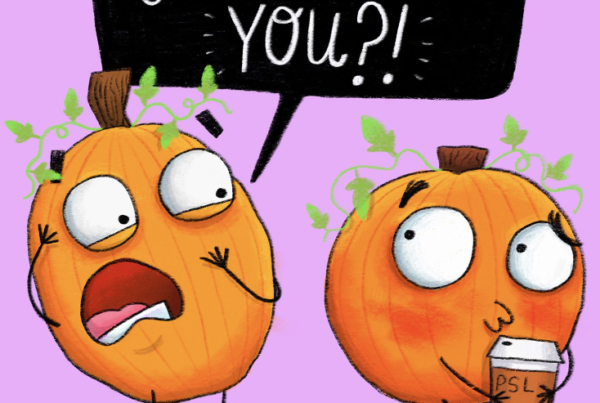By Morgane Brière

Grey skies over Budapest. Photo: Morgan Brière// The Sundial Press
February break was fast approaching as we all sat in a poorly-made circle on the floor of our Residium living room. We had a free week before midterms to do whatever we pleased, and the only thing we were certain of was that it would not be spent studying.
With this being the only surety I had to work with, my plans were far from stable. Our circle of ideas took less than five minutes to degenerate into tears, insults and general chaos. With less than two weeks to spare before the break and far too many potential travel buddies, we realized we could not accommodate everyone and decided to break off.
We didn’t know where we were going, but we knew that in 15 days we would be headed for the airport. Every new day brought a new destination to the surface–they ranged from Copenhagen (too cold), to Rome (no – that’s a summer destination), to Barcelona (oh wait – no that is too!). Finally we settled on Budapest–with decent airfare and its rumoured cheap living we figured it would even out and meet our budget. The perfect compromise was met–but we knew next to nothing about our destination.
As the three final contenders of our last-minute Budapest escape we quickly swallowed the higher-than-we-would-have-liked prices of our tickets, and began the search for our accommodation. We stumbled upon a beautiful apartment in the 6th district of Pest equipped with a sauna, which after our long days of touristing in the snow and subzero temperatures began to seem like the place’s worthiest attribute. The rent was less than 50 euros a person, definitely evening out the last minute costs of our airfare.
In general, daily life in Budapest had a fairly low cost and allowed us the luxury of having a fairly exorbitant hourly coffee stop to sightseeing ratio. At the very beginning of our trip we exchanged about 150 to 200 euros into Hungarian forints at the nearest currency exchange. We received about 60,000 HUF in return–with an exchange rate of about 314 HUF to 1 euro. While we knew life was rumored to be cheap, we thought it best to take out at least that much. In the end, we left Budapest with a few hundred forints left over and could have definitely done without the extra cab rides. We concluded that four days in Budapest could be lived on a much tighter budget.
With more than 60,000 HUF on hand we stopped at virtually every good looking restaurant and twice at our neighbourhood’s best cafes. After only the second morning, the nearby Ecocafe had become our favorite spot for morning pastries and lattes–and goulash soup was our go-to lunch order. We tried chicken paprikash, chimney cakes and a variety of hungarian wine (ranging from cheap supermarket buys to those by-the-glass). The food was always great whether it was the various traditional hungarian eats or the pad-thai we had on our last night.

Chicken Paprikash. Photo: Morgane Brière//The Sundial Press

Goulash soup. Serious-Eats. Photo: Morgane Brière//The Sundial Press
We did, however, do more than just eat and drink coffee–the city was an amalgamation of one amazing building after another. With snow, grey skies, and white stone edifices Budapest has the aesthetic of a dream. Our first day was spent familiarizing ourselves with our neighbourhood. Our apartment was less than five minutes away from the House of Terror, Budapest’s museum dedicated to life under totalitarian regime, and just a street away from Andrassy Avenue. The city’s biggest boulevard has high-end boutiques, great cafes, nice restaurants, and in the middle of it all is the opera house. It was our first stop of the day as we debated between staying to watch a performance or going for lunch. In the end, the smell of goulash won, and we ran across the street to sit and escape the frigid temperatures of that February storm.
Having seen the opera and with full stomachs we headed towards St Stephen’s Basilica, named in honour of Stephen, the first king of Hungary. The building itself is impressive, but our favorite part of the visit was the view from the top. We climbed the 364 steps, into the bell towers, and we were well rewarded–the basilica granted us a panorama of the city like we had never seen before. It was snowing that day, and with the covered skies the capital was enchanted. After a debate on whether “that” building was really the Hungarian parliament or if it was in fact on the other side of the Danube we headed back down the infinite stairway of the tower. It had gotten even colder with temperatures dropping to negative ten degrees celsius, and another coffee break announced itself just around the corner. With the motivation of first-day-travellers we left our warm and cozy coffee shop and crossed the Danube river.
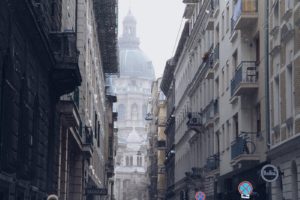
View of Basilica. Photo: Morgane Brière//The Sundial Press
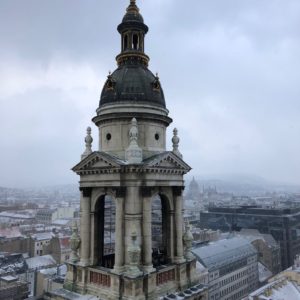
View from top of Basilica Photo: Morgane Brière//Sundial Press
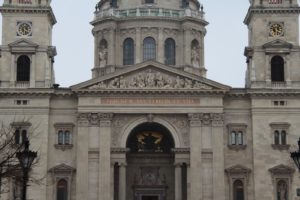
St Stephen’s Basilica. Photo: Morgane Brière//The Sundial Press
Budapest was historically two cities separated by the Danube, today Pest and Buda are brought together by two bridges, a subway and a few trams. As tourists we had not yet discovered the metro system and therefore embarked on the journey by foot. This allowed us to see the parliament–which we rightly identified this second time–as well as Buda castle. Our goal of the evening was to reach the castle and then perhaps the museum of Budapest’s History. As we climbed and climbed, both our accomplishments and the view seemed increasingly fantastic. We arrived too late to visit the castle itself, but its gardens and facades almost made up for it all. Our day of visits ended there as we hopped on the first bus we saw and headed down Buda Hill and across the river. This was our first time taking the subway in Budapest–with four lines connecting the city and the smallest trains we had ever seen. Speaking no Hungarian whatsoever we relied mostly on the few recognizable sounds and inflections, so for our already frozen ears Vorosmarty Ter and Vorosmarty utca sounded much the same. This began our series of unforgettable subway mishaps and dangerous encounters with trams. We were unassuming tourists with little preparation, and the locals saw right through us. From almost getting run over by a hurried tram-driver, to being the only people pulled aside on a crowded train, we were easy targets.
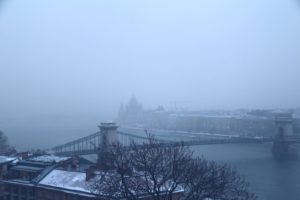
View from Buda Castle. Photo: Morgane Brière//The Sundial Press
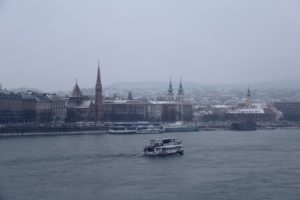
Danube river. Photo: Morgane Brière//The Sundial Press
When we finally reached our apartment, we ran off to make tea and quickly prepare the sauna for the first defrosting session of our trip. That night we braced ourselves for the second wave of cold and visited a restaurant recommended by friends, and once again the food was great. Our favorite restaurant was situated near the Danube in a large loft-like space–the bar in the middle of the room was surrounded by large tables and great deco. Budapest’s food scene was impressive as the different restaurants ranged from trendy to sophisticated to just simply delicious.
Our second day was also the coldest. We slept in, went for coffee and pastries, and finally decided it was time for us to visit the neighborhoods of Budapest. We had heard about the Jewish district and therefore headed off into the direction indicated to us by Google maps. However, having typed in “Jewish district” our phones directed us somewhere far from our intended destination. And that’s when we ran into the Budapest subway control. After our confusing ride around the city, we were taken off the tram by three women dressed as civilians. They were armed only with badges and asked us to step down and present to them our tickets. With their casual dress and discrete identification we found the situation resembled the scams our parents had warned us about. After perhaps too long trying to prove our sham we acquired a deal: we would have to pay the price of two “fraudsters”. It was only once they showed their badges and threatened us with a call from our embassy that we gave in and believed in the legitimacy of their role. With our parkas, snow boots and general tourist-wear we were the perfect targets: Beware they have little pity for confused travelers.
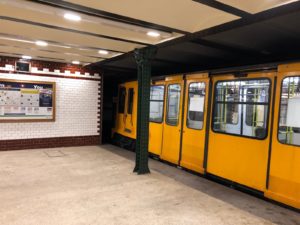
Line 1 Subway. Photo: Morganie Brière//The Sundial Pres
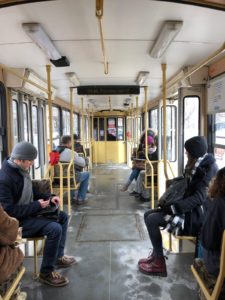
Inside the tram. Photo: Morgane Brière//The Sundial Press
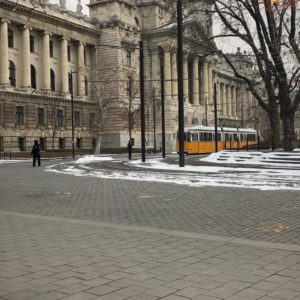
Tram Parliament. Photo: Morgane Brière//The Sundial Press
With the pain of losing what we saw as a great-meal’s worth in a simple misunderstanding – we decided to take the day a little slower. Our tram-ride was stopped right in front of the Hungarian National History museum, which is why we chose to find our refuge from the cold weather and unforgiving control officers. The museum was extensive and brought back faint memories of our history course–all three of us were very proud to have remembered Kossuth and his 1848 revolution. It was a day of museums, as we had planned to visit the reputed House of Terror. It amalgamated the regimes of terror that Hungary faced throughout history all within a building that had been used by the Arrow Cross Party and the Hungarian secret police. The experience was moving, and the atmosphere certainly gave the impression of entering a totalitarian regime. The music was somber, the lighting was austere and the staff were inexpressive and curt in their speech. Everything about the place screamed “House of Terror”.
After the darkness of that visit we noticed a chimney cake boutique and felt the undeniable urge to try the sweet treat. We had heard so much about it from friends and family who advised us to taste but most importantly to share. While we did as we were told and enjoyed the spirit of the desert our foodie-consensus fell on Goulash being our favorite discovery. That night we made up for our lost forints and ate at home, however we made a point of picking up some hungarian wine for dinner.
The next day we booked a guided visit of the Hungarian Parliament. The building was a sight in itself, and the guide was able to explain all the parliamentary procedures and historical customs. The Hungarian parliament is the country’s largest and tallest building and stands as a symbol of the sovereignty of the nation. We concluded our day by visiting the Thermal Baths of Gezert Hill, an experience which ranged from relative discomfort to a pleasant and warm shelter from the cold. We chose to visit the outside baths, where you could find a sauna and a cold water bassin. The view from the baths were great, but the water was little warmer than inside. In all it was definitely worth doing, but we favored the sauna we had at home. As we headed home on the tram, we feared the controllers even with our validated tickets, and at every stop we made sure we were safe.
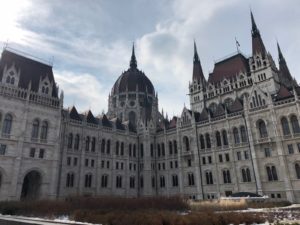
Hungarian Parliament. Photo: Morgane Brière//The Sundial Press
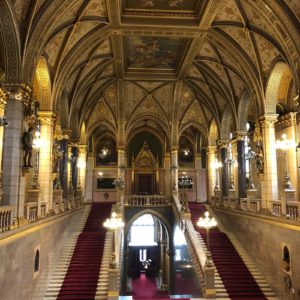
Royal Staircase Parliament. Photo: Morgane Brière//The Sundial Press
Friday was our last day, and with that we made the best of it. We went for brunch near the Danube and ate to our heart’s content. Szimply was only a bridge away from Buda, so we decided we could not leave the city without visiting the Fisherman’s Bastion. Built around Matthias Church, the bastion is a neo-Gothic terrace on the castle hill and was probably our favorite attraction. The white stone, the carvings, and the view it gave onto Pest brought us to stay out in the cold much longer than our typical 20 minutes. Buda was on the other side of the city, and therefore we spent little time there. All three of us felt however that if given a chance to return to Budapest, we would spend more time near the castle to wander the hills and boutiques across the Danube.
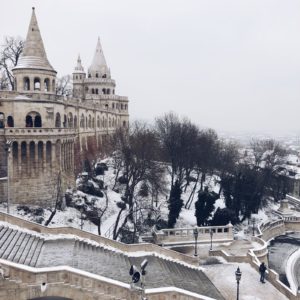
Fisherman’s Bastion. Photo: Morgane Brière//The Sundial Press
Our trip had few expectations attached to it, and I believe that’s what gave it so much of its charm. Our decision was last minute and our research so minimal that we barely knew two-words of Hungarian upon our arrival. This allowed us to see the city in perhaps more realistic way and gave us the ability to find excitement in every new thing we encountered. The trip may have been a cold one but it was certainly worth it to see Budapest under the snow and grey skies.
Other posts that may interest you:
- Carbon dioxide removal – hit or miss?
- Local Victories for Turkish Opposition — A Sign of Hope?
- Are France and Japan a Mismatch Made in Heaven?
- A Reflection on Dark Tourism
- Cadavre Exquis : Goodbye stranger
Discover more from The Sundial Press
Subscribe to get the latest posts sent to your email.



